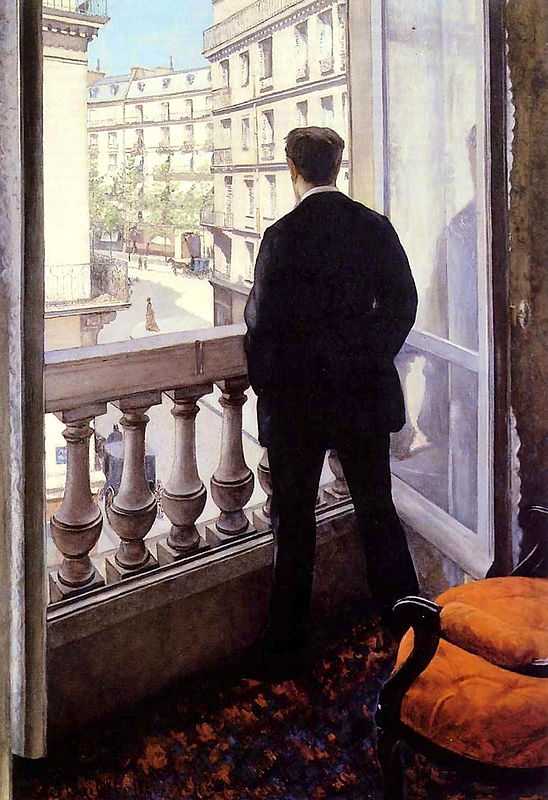1. The Floor Scrapers (1875)
‘The Floor Scrapers’ is one of two paintings Caillebotte produced featuring this particular type urban of labourer.
Both pieces were shown at the Second Impressionist Exhibition of 1876.
The first and best-known depicts three men working on a wooden floor. The perspective looks down on the men and their muscular torsos, their faces mostly obscured.
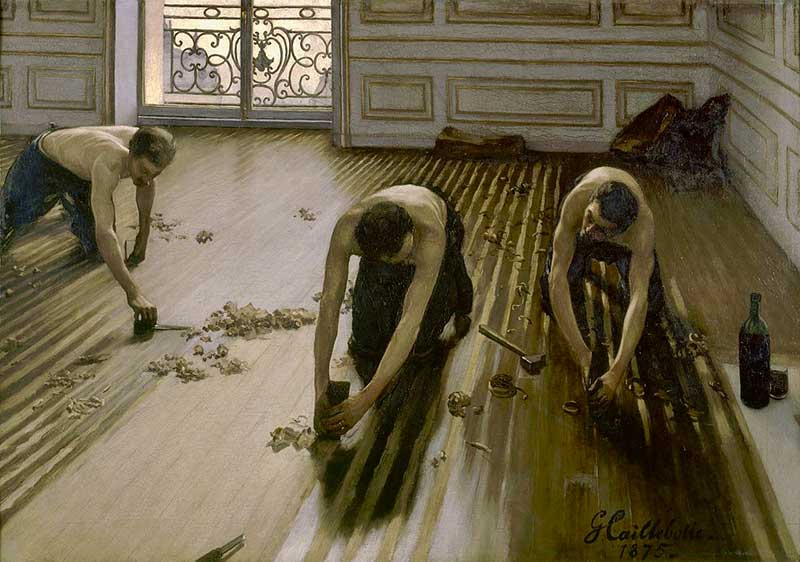
The lesser-known Floor Scrapers
The second piece features two more labourers: the younger (in shorts) pausing to sharpen his blade, the elder (his father?) hard at work.
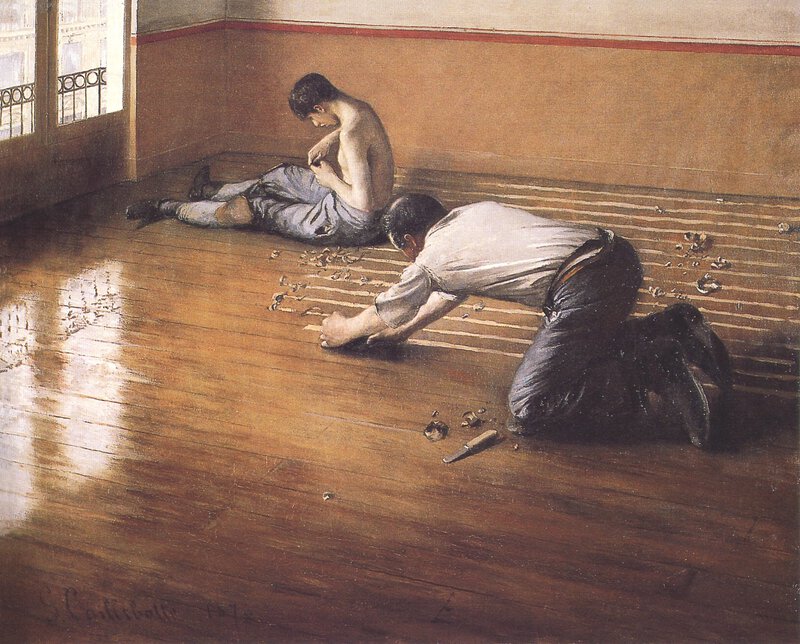
It is likely that Gustave Caillebotte based these studies on labourers working on the hardwood floor of his own studio. Indeed, the perspective of the piece gives the Impression of having walked in to the room to watch the work.
As in Caillebotte’s water scenes, he pays careful attention to the reflections of the light on the polished surface of the floor.
Critical reaction
These paintings were criticised by more conservative critics and visitors to the Impressionist exhibition. Presenting urban labourers in art was an extremely radical choice of subject matter. Albert Wolff said:
“Some people are content to laugh at such things. But it makes me sick at heart”.
However, other writers and artists praised Caillebotte’s fresh approach to painting and his use of subjects drawn from everyday life in Paris which exemplified the aims of the Impressionist movement.
Where is it now?
The more famous Floor Scrapers is found in Paris' Musee d'Orsay. The lesser known is housed in a private collection, though is occasionally loaned out for exhibitions.
Learn more about the artist on our Caillebotte Biography page.
2. Le Pont de l’Europe (1876-77)
This piece is a shining example of Caillebotte’s focus on urban life in Paris.
Constructed in 1865-1868, the Pont de l’Europe was part of a series of monumental changes overtaking the city as part its rapid industrialisation.
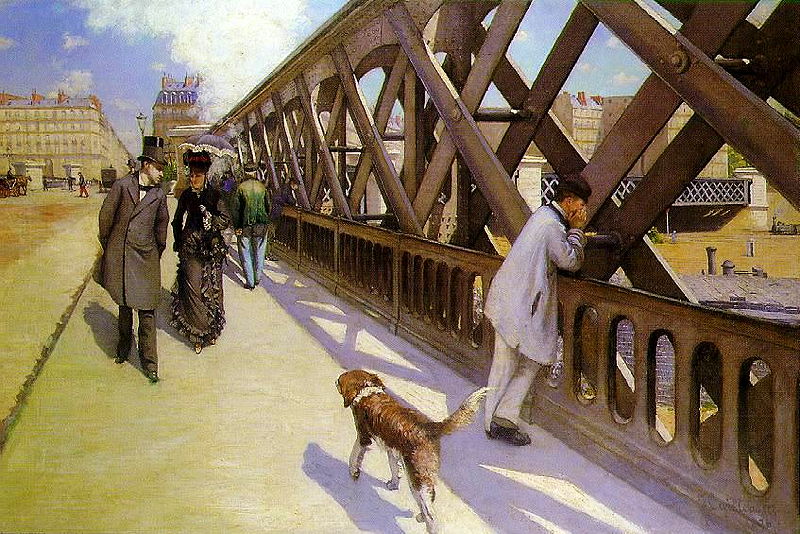
Crossing the Gare Saint-Lazare
The bridge was designed to cross the railway yards Gare Saint-Lazare, a railway station that was itself rapidly expanding. The bridge became a symbol of the changing city, the growth of the railways and the movement of people through the space.
For Caillebotte, the Pont de l’Europe would have become a central feature of his life in the city. His family home was just a ten minute walk from the construction, at rue de Miromesnil in the Quartier de l’Europe.
The artist would also have crossed the bridge to get to Cafe Guerbois and the Cafe de la Nouvelle-Athenes where the Impressionists frequently met.
Two versions of the bridge
‘Le Pont de l’Europe was one of two large scale paintings Caillebotte made of the bridge in 1876-77. Both aimed to highlight the severity of the structure and its industrial essence.
- In one of the pieces, the bridge is shown looking down one of the roads. An unleashed dog, presumably a stray, is in the foreground together with three figures: a solitary man looking down at the workings of the railway, and a couple (the man fashionably dressed, the woman in black - perhaps signifying that she was a prostitute).
- In the other, the viewer is parallel to the bridge, with the iron structure cutting across the canvas. He is looking with interest at the workings of the railway yard, his posture suggesting that he is taken aback by what he is seeing.
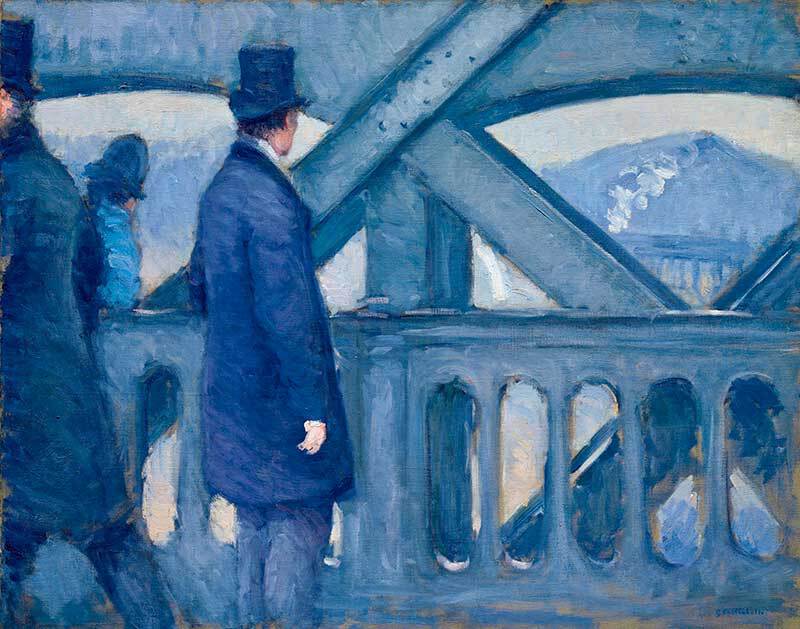
Together, the paintings present a story of a figure crossing the bridge who then stops to look down into the rail yard.
Modern technology
In ‘Le Pont de l’Europe’, Caillebotte plays with different ways of looking at technological development
As Julia Sargraves describes,
“They are transfixed by the spectacle of modern technology, as if held firmly by the crossed and bolted iron girders of the Pont de l’Europe itself”.
The girders aid in the figures’ view of the city, helping to create a physical framework that structures their interaction with the urban landscape.
Where are they now?
The version with the dog is found in Geneva's Museum de Petit Palais, and the version with the man looking quizically at the structure in Texas' Kimbell Art Museum.
3. Paris Street, Rainy Day (1877)
One of the stars of the 1877 Impressionist Exhibition, ‘Paris Street, Rainy Day’ represented a radical new addition to avant-garde art in Paris.
The scale of the piece is enormous, measuring around seven by ten feet and the figures in the foreground are life-size.
By choosing such a scale, Caillebotte established the work as a monumental piece depicting modern, urban life.
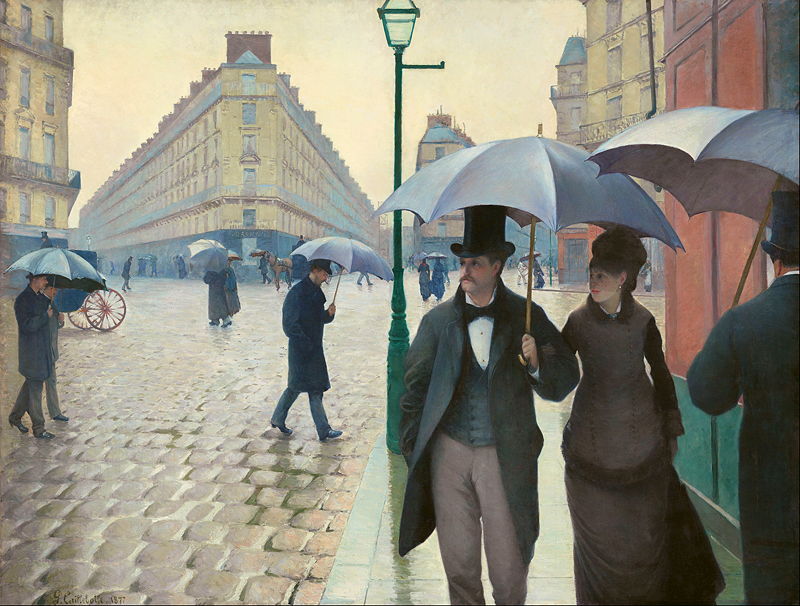
The Paris street is the intersection close to the Gare Saint-Lazare and is typical of Baron Haussmann’s redesign of the city.
A decorator and a maid
The figures are also indicative of the modern city, dressed fashionably in contemporary clothes. Crucially, behind the wealthier figures in fur and top hats, Caillebotte also included two working-class figures: a decorator and a maid.
They are very small and often go unnoticed. But this should help:
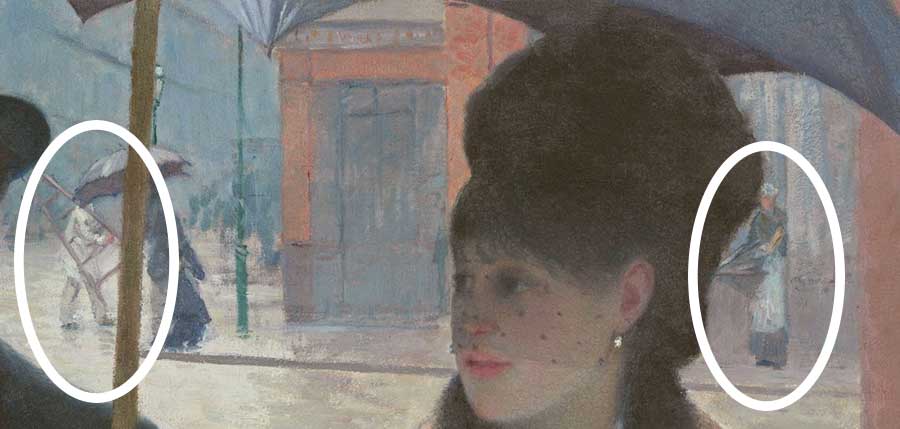
This piece is notable because of its academic style. Unlike the sketch-like technique of the Impressionist movement, with visible brushstrokes, this piece is neat and highly crafted.
It echoes academic paintings that one would have expected to see in the Paris Salon and this brought it more attention at the Third Impressionist Exhibition.
Where is it now?
Paris Street, Rainy Day is now found in the Art Institute of Chicago.
4. The House Painters (1877)
Once again taking modern, urban Paris as his focus, Caillebotte painted ‘The House Painters’ in 1877.
This piece depicts four men working on the outside of a building on one of the wide boulevards that had been newly built in the city.
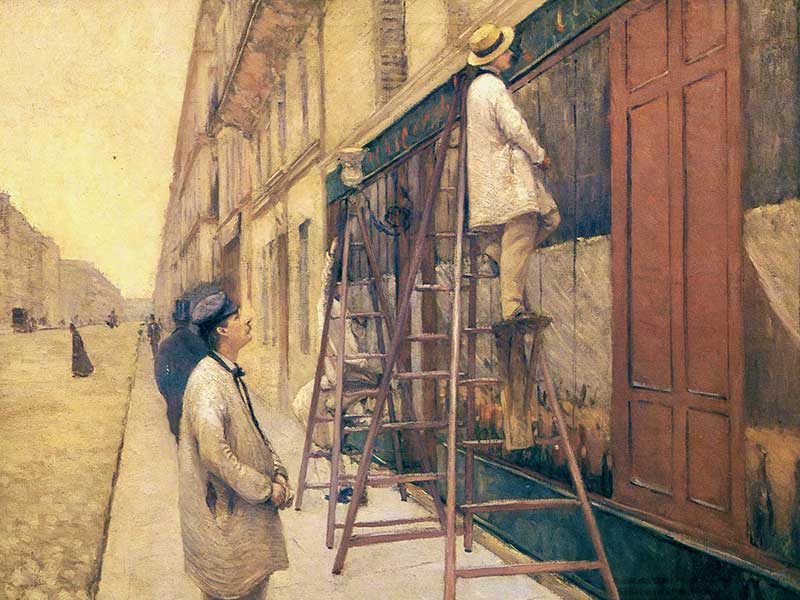
Dreary?
The scene is somewhat grey and bleak, the streets is largely empty save for a handful of pedestrians dressed in grey and black. The only colour in the piece is from the newly painted walls of the wine merchant’s store in the foreground.
Labourers ... not Lords
What is notable about this work is that Caillebotte chose to document urban labourers in Paris. Men from the lower classes, doing manual labour, was not a feature in art at this time. Caillebotte showed this particular piece at the 1877 Impressionist Exhibition and he later repurchased the work for 301 francs.
This piece has been linked to early Cubist principles. Caillebotte’s perspective works on different planes: the first two workmen form part of one plane while the street behind them is painted on another plane. This gives the painting a striking quality.
Where is it now?
Alas, Caillebotte's The House Painters is held in a private collection.
5. Oarsmen Rowing on the Yerres (1877)
‘Oarsmen Rowing on the Yerres’ is arguably one of Caillebotte’s most ambitious works with regard to his use of perspective.
The painting is cropped, focussing solely on the boat, the two oarsmen and the shining water immediately surrounding them. In the foreground, one man reaches forward to begin his stroke, his head tilted downwards.
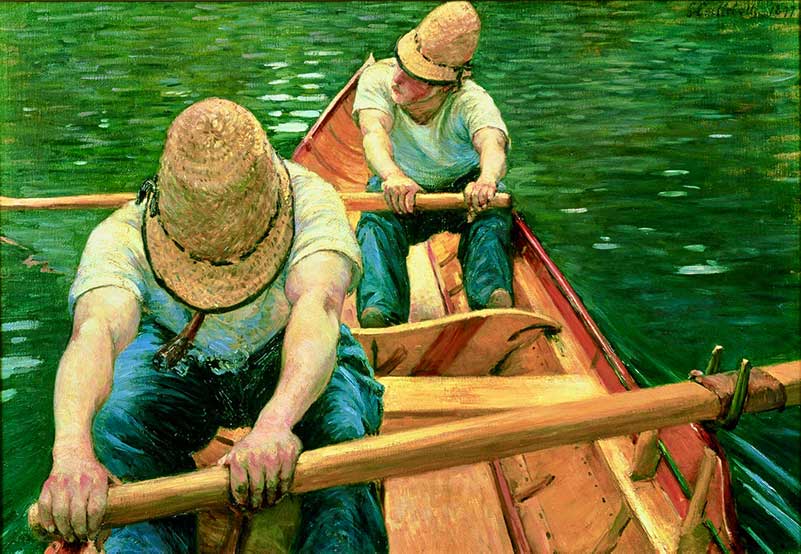
As a result of this positioning, his face is completely obscured by his hat, leaving him a faceless figure despite dominating the painting.
The wooden boat
The wooden boat itself is also painted with extreme care, showing Caillebotte’s technical eye and familiarity with boats.
The colour choice is bold and the painting is executed with a number of short brushstrokes. Caillebotte also painted ‘Skiffs’ in the same year, which was shown at the Fourth Impressionist Exhibition in 1879 where it was called ‘Flat-Bottom Canoes on the Yerres’. These paintings demonstrate Caillebotte’s interest in painting water scenes.
Outdoor scenes
As well as painting urban life, Caillebotte often left the city to paint outdoor scenes. His family had estates in the villages of Yerres and with his brother he purchased a property at Petit Gennevilliers situated on the banks of the Seine.
Watersports
In his leisure time, Caillebotte was an enthusiastic yachtsman and rower and he owned a number of sailboats.
This was typical for men of his social status as boating and yachting became especially popular during the latter half of the 19th century. Caillebotte was Vice-President of a sailing club called ‘Le Cercle de la Voile’ and even built a boatyard.
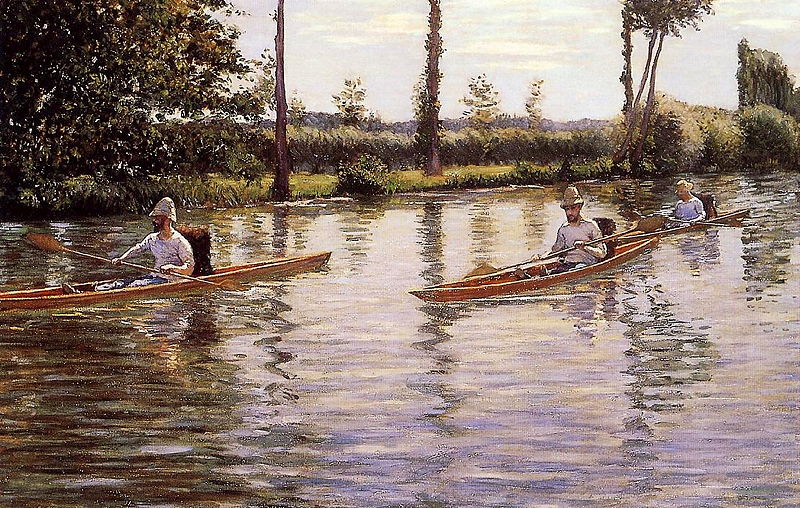
Over time, he established a reputation as a renowned designer and yacht builder. His boat-themed paintings hint at his passion for the sport.
Where is it now?
Oarsmen Rowing on the Yerres is now housed in a private collection.
6. View Seen Through a Balcony (1880)
Caillebotte returned to the image of the balcony time and again in his works.
Caillebotte often placed figures on balconies, looking out over an urban scene as in ‘Man on a Balcony’ (1880), ‘Man on a Balcony, Boulevard Haussman’ (1880) and ‘Young Man at his Window’ (1875).
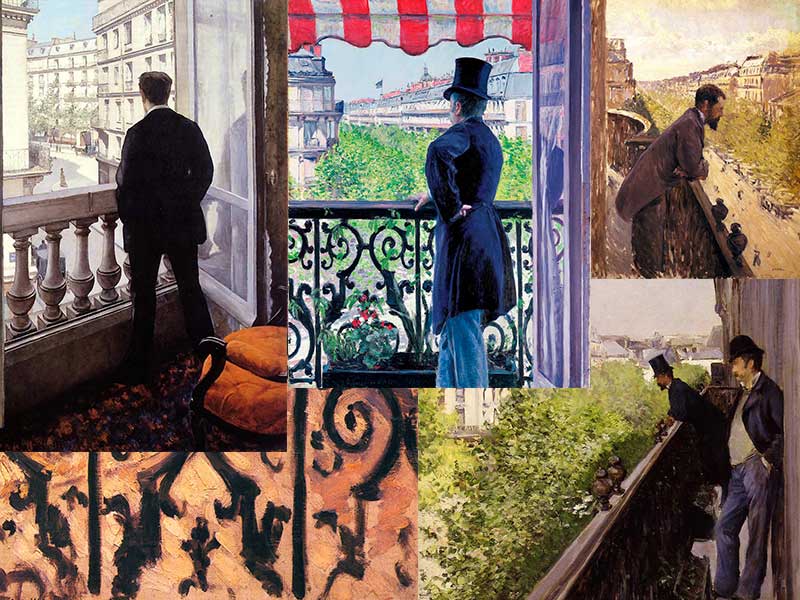
In these works, the balcony serves to create a feeling of separation for the figures whilst also feeding into the idea of observation and viewing in a modern, urban world.
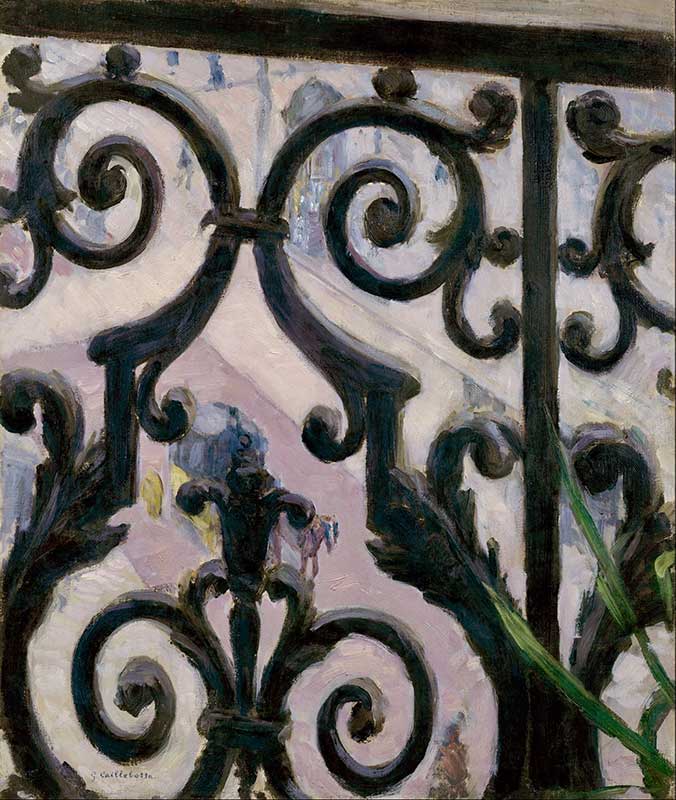
View Seen Through a Balcony
‘View Seen Through A Balcony’ hints at the same aim but it is unique in its composition. The focus of the work is the ironwork of the balcony itself rather than the view. The pattern of the ironwork fills the whole canvas.
This painting was made by Caillebotte using the view from the balcony of his Paris home. It is possible to make out a few details of the pastel-toned city behind the balcony, such as a carriage and an advertising column.
Japanese Influence
Caillebotte’s unusual composition for this piece was likely inspired by Japanese prints, which favoured this bold cropping technique as well as the use of solid colours.
He was not the only Impressionist to be inspired by Japonisme: it had a significant influence on Monet's Impression: Sunrise.
van Gogh
Vincent van Gogh was intrigued by Caillebotte's work. When he heard that View Seen Through a Balcony was on display in Paris, he wrote to his brother Theo to say:
‘there’ll be some works by Caillebotte – I’ve never seen anything of his, and wanted to ask you to write and tell me what they’re like.’
Where is it now?
This piece was first exhibited at the fifth impressionist exhibition of 1880. It is now found in the van Gogh Museum in Amsterdam.
7. Nude on a Couch (1880)
‘Nude on a Couch’ is one of the two female nudes Caillebotte painted during his career.
The scale is grand and the figure is close to life-size. Despite being one of the Caillebotte's largest canvasses, this painting was exhibited only rarely.
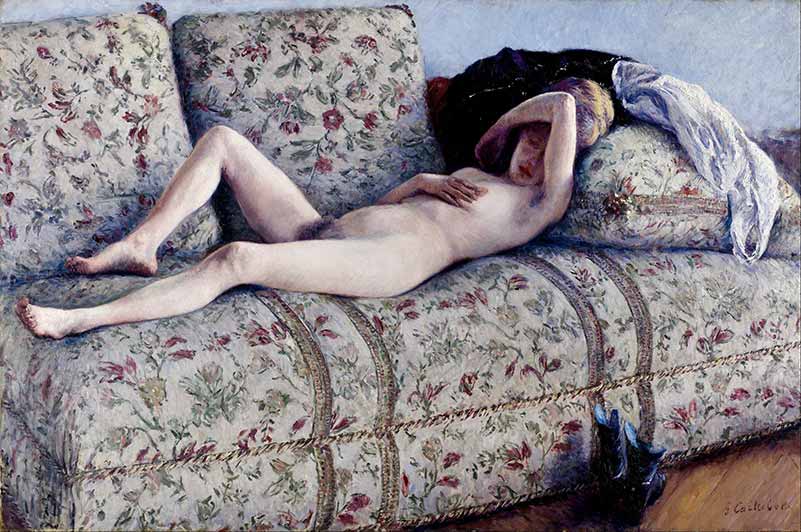
The pose
The model's pose is unusual, almost languid, with one arm crooked over her face.
What is interesting is the relaxed nature of the woman’s position. She is lounging on the couch, not for the benefit of any male observer, as in Manet’s Olympia, but in an entirely unselfconscious way.
Her clothes are dropped behind her head and her boots are on the floor. It is easy to imagine her walking into the room, perhaps in the height of summer (in the days before air conditioning!), getting undressed and flinging herself down on the couch.
The model's body
The pale skin of the figure contrasts starkly with the detailed patterns of the couch fabric. Her body is also that of a modern woman, she is not curvaceous or angelic.
Instead, her limbs are slim and she has pubic hair which is uncovered and visible in the painting. In the words of Kirk Varnedoe, a scholar and curator, this is a “realist nude” that “belongs to a story”.
A new nude ...
Caillebotte’s ‘Nude on a Couch’ is also a unique painting among the works of the Impressionist movement. Though Edgar Degas is known for his nudes, painting women undressing or at their toilette, Caillebotte’s piece is the only one where the woman has got undressed in the room she is now lying in.
This gives the scene a greater sense of immediacy and also informality.
Where is it now?
Nude on a Couch is now housed in the Minneapolis Institute of Art.
8. Man at his Bath (1884)
In ‘Man at his Bath’ from 1884, Caillebotte invites the viewer into an intimate yet ordinary moment, a man drying himself in the privacy of his bathroom.
With his back turned, the man maintains a distance from the viewer but the pose also adds to a feeling of voyeurism.
We are looking in on the figure, observing him perhaps without his knowledge.
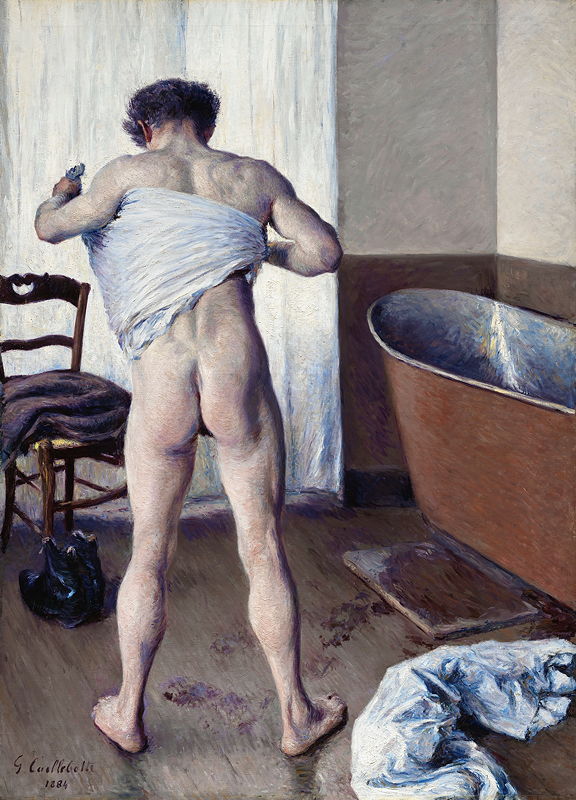
Male nude?
This piece is unusual in that it features a male nude, which was extremely uncommon at this time. Indeed, when first shown at the Less XX exhibition in Brussels in 1888, the painting was so controversial that it had to be removed from public display.
Caillebotte paid particular attention to the form of the nude’s body. He used neutral colours with bluish and grey tones to highlight the shadows on his muscular form, particularly on his back, shoulders and callipygian (well-shaped) buttocks. The use of natural light adds to the unposed feeling of the piece.
Intimacy and immediacy
Caillebotte’s composition establishes a sense of intimacy and immediacy.
He emphasised the curves of the man’s body by echoing them in the curves of fabric on the floor, the lip of the bathtub and the lines of the chair. He contrasts this with the linear fall of the curtains, the corner of the room and the man’s upright posture.
In terms of immediacy, the viewer can see the fresh footprints on the bathroom's floor, the work-boots in front of the chair, and the discarded white coverall on the bottom right hand side of the canvass - this guy couldn't wait to get clean after a hard day's work.
Another key feature of the work is its size - measuring 145 x 115 cms, it is almost life sized.
Similar themes can be seen in ‘Man Dries His Leg’, also painted in 1884. This piece depicts another intimate moment set in the same bathroom, likely using the same model.
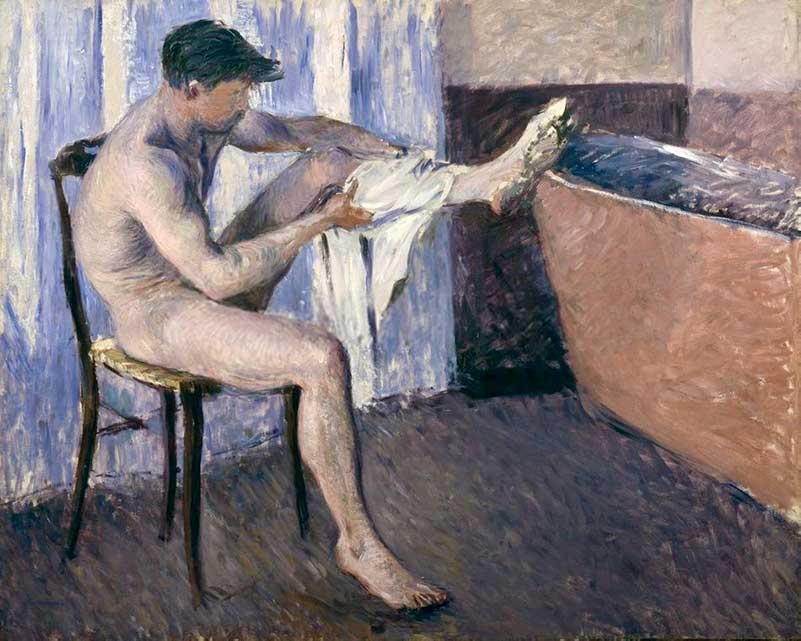
This work is painted more as a sketch, lacking some of the realism of ‘Man at his Bath’.
Where is it now?
Man at his Bath (Homme au Bain) was held in a private collection until 2011, when it was bought for about $17m by the Museum of Fine Arts, Boston.
Interesting fact...
The MFAB couldn't find a donor willing to stump up $17m for a male nude, so it de-accessioned (i.e. sold) seven other impressionist works to be able to buy Man at his Bath. They included a Renoir, two Sisleys, a Pissarro and a Monet. The decision was extremely controversial at the time.
9. Sailing Boats at Argenteuil (1888)
Having moved out of Paris in 1881, Caillebotte began painting more views of boats and the water.
In doing so, he followed the move of several other Impressionist artists including Claude Monet, Auguste Renoir and Alfred Sisley who had begun doing the same.

As Paul Hayes Tucker describes, the painters’ views from Argenteuil
"constitute one of the most remarkable bodies of work in the history of art, making Argenteuil synonymous with Impressionism and a touchstone for the development of Western visual culture”.
As with his piece ‘Boats Moored on the Seine’ (1892), ‘Sailing Boats At Argenteuil’ is Impressionist in its style.
Caillebotte was often referred to as a Realist painter but in these pieces we see his embrace of Impressionism. In particular, he used thick brushstrokes to capture the effect of the gentle waves in the water, distorting the otherwise straight sails of the boats.
These broad strokes contrast to paintings with similar themes produced by Monet and Renoir.
Argenteuil
The popularity of sailing at Argenteuil had been established by the 1867 Exposition Universelle when a large sailing competition was held at this point on the Seine.
In an 1870 guidebook there is a description of close to 200 sailing boats moored at Argenteuil.
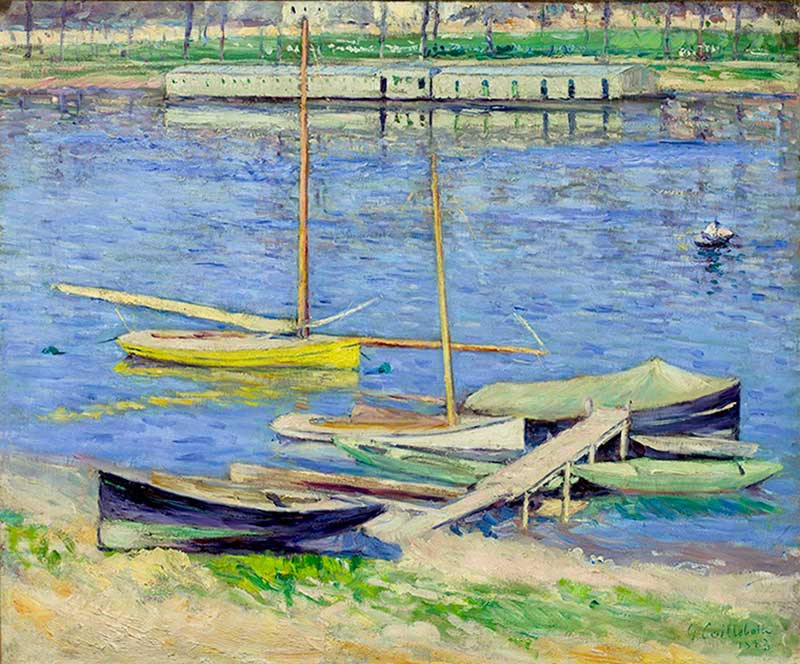
As Robert Herbert explains in his book ‘Impressionism: Art, Leisure & Parisian Society’, at this time Argenteuil was “a setting that permits middle-class Parisians to let air, light and river sports soothe away anxieties of the city”.
He goes on to state:
“In truth the major changes along these shores had been brought about by the pleasure boats, so the artist was right to give them first place in the modern landscape.”
Where is it now?
Sailing Boats at Argenteuil is now housed in Paris' Musee d'Orsay.
10. Chrysanthemums in the Garden at Petit-Gennevilliers (1893)
After purchasing his estate at Petit Gennevilliers, Caillebotte became an avid gardener.
From the 1880s onwards, he began painting more still life works featuring flowers and particularly chrysanthemums, which he grew in his garden along with a variety of other plans.
Perspective
‘Chrysanthemums in the Garden at Petit-Gennevilliers’ is an interesting piece because of Caillebotte’s use of perspective. The viewer is taken extremely close to the flowers, which we can see are still planted.
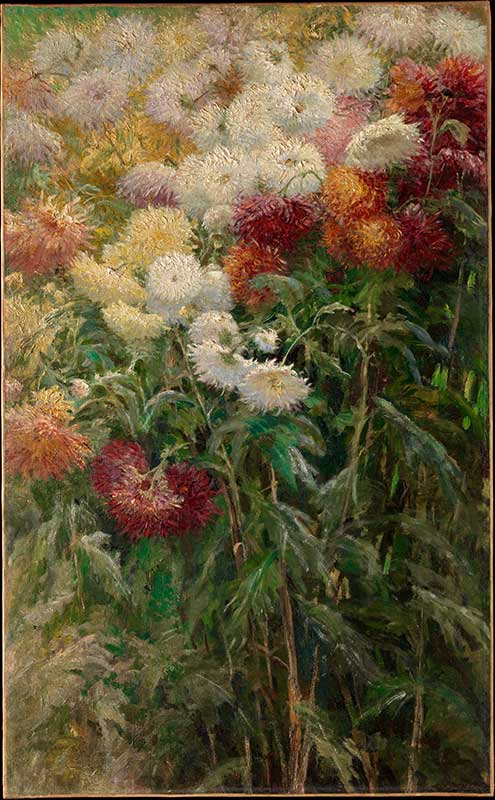
This was unusual for paintings of flowers at this time as they would normally have fallen into two categories: still life works with cut flowers placed in a vase, or live flowers viewed from further away in the context of a garden or park.
To produce a still life of flowers growing outdoors was something new and even shocking for contemporary viewers.
The painting is also closely cropped so that the flowers themselves are emphasized. The effect is a mass of blooms, lit by sunlight from the left and casting a shadow on the stalks and leaves. The direction of the light highlights the delicate petals of the flowers.
A photograph?
In many ways, this painting is reminiscent of a modern photograph. It is a quick snapshot of a beautiful scene, as though it has caught the viewer’s eye as they walk past. This is one of the things that makes the work special, it has a feeling of immediacy that makes it firmly Impressionist in style.
This piece may have been intended to form part of a decorative panel, or may have drawn inspiration from such panels, particularly a pair of dining room doors. This would in part explain the closely cropped and dense composition of the piece, as well as the shallow spatial organisation.
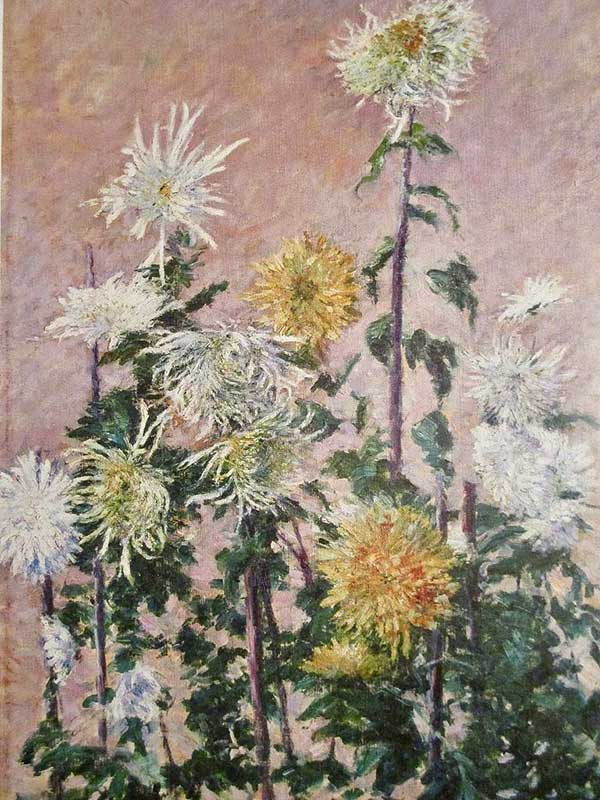
Passion for plants
It was not Caillebotte's only painting of chrysanthemums. Indeed, he shared a passion for gardening with Claude Monet, with whom he often corresponded sharing horticultural tips!
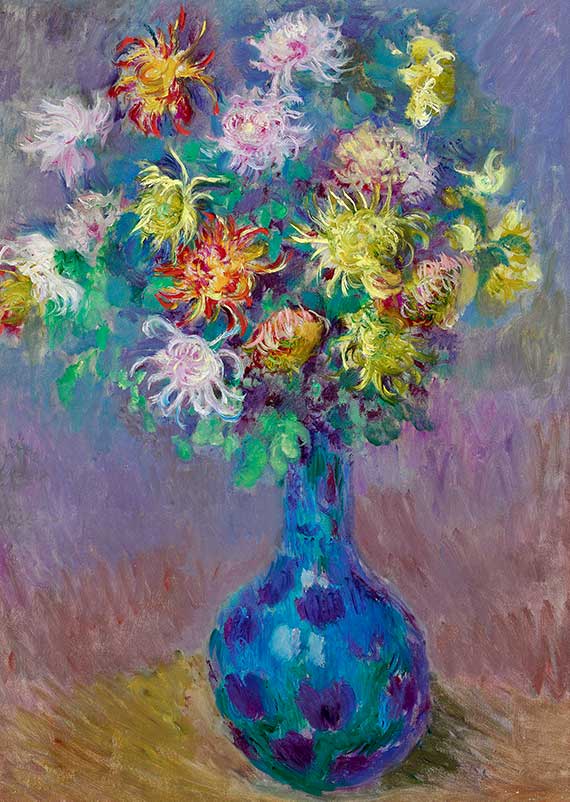
Where is it now?
Chrysanthemums is found in New York's Met.




